When it comes to choosing an engagement ring, the focus often lands on the diamond or main gemstone. However, the band — the very foundation of the ring — plays an equally crucial role.
Not only does it influence the ring’s overall look, but it also determines its durability, comfort, and symbolism. This choice is not just about aesthetics; it’s about finding a material that resonates with your lifestyle, values, and love story.
Understanding Your Options: From Classic to Contemporary
Engagement ring bands come in a diverse palette of materials, each with unique properties and meanings. Here’s a snapshot:
- Gold (Yellow, White, and Rose)
- Symbolism: Traditionally represents purity and fidelity.
- Pros: Timeless appeal, malleability for intricate designs.
- Cons: Requires regular polishing, can be prone to scratches.
- Platinum
- Symbolism: Connotes prestige and endurance.
- Pros: High durability, hypoallergenic, doesn’t tarnish.
- Cons: More expensive, can develop a patina over time.
- Silver
- Symbolism: Associated with clarity and purity.
- Pros: More affordable, offers a classic look.
- Cons: Softer metal, prone to tarnishing and scratches.
- Titanium
- Symbolism: Represents strength and invincibility.
- Pros: Lightweight, extremely durable, hypoallergenic.
- Cons: Limited styles, difficult to resize.
- Alternative Materials (Wood, Ceramic, etc.)
- Symbolism: Varies, often unique to the wearer’s story.
- Pros: Distinctive look, often more affordable.
- Cons: Can be less durable, not traditional.
As we explore these materials in depth, consider what each one signifies to you. Are you drawn to the classic elegance of gold, the strength, and modernity of platinum, or the unique character of alternative materials?
Your choice is a testament to your personal style and the enduring bond it symbolizes. Remember, the right material not only complements the gemstone but also stands as a lasting emblem of your commitment and love.
< class="wp-block-separator has-alpha-channel-opacity"/>Gold: The Timeless Choice
Gold has long been the quintessential choice for jewelry, especially engagement rings. Its history as a precious metal dates back to ancient civilizations, where it was revered for its beauty and rarity. Today, gold remains a symbol of elegance and enduring love, making it a popular choice for couples around the world.

Diving into the Varieties of Gold
Gold’s versatility is reflected in its various forms:
- Yellow Gold
- Composition: A mix of pure gold, silver, and copper.
- Characteristics: Classic gold color, provides a warm and traditional look.
- Ideal For: Those who prefer a timeless, vintage appeal.
- White Gold
- Composition: Pure gold alloyed with white metals like nickel or palladium, often coated with rhodium.
- Characteristics: Silver-tone, more contemporary look.
- Ideal For: Those looking for a modern twist on the classic gold.
- Rose Gold
- Composition: Pure gold mixed mainly with copper.
- Characteristics: Pinkish hue, offers a unique and romantic feel.
- Ideal For: Those seeking a distinctive, yet vintage style.
Pros and Cons of Choosing Gold
- Pros
- Versatility: Suitable for a wide range of designs and gemstones.
- Value: Holds its value over time, making it a worthwhile investment.
- Hypoallergenic: Particularly true for higher karat numbers.
- Cons
- Maintenance: Requires regular cleaning and polishing.
- Softness: Higher karat gold can be more prone to scratches and deformations.
- Alloy Sensitivities: Some people may be allergic to certain metal alloys used in lower karat gold.
In essence, gold is more than just a metal; it’s a testament to your journey. Whether you lean towards the warmth of yellow gold, the sophistication of white gold, or the romance of rose gold, each variety brings its own story and symbolism to your engagement ring.
The choice of gold is not just about the color or the cost; it’s about finding the piece that resonates with your personal story and the love it represents.
< class="wp-block-separator has-alpha-channel-opacity"/>Platinum: The Premium Metal
Platinum, with its elegant sheen and exceptional durability, stands out as a premium choice for engagement ring bands. This rare metal has garnered a reputation for its sophistication and timeless appeal, making it a favored choice for those seeking a blend of luxury and practicality in their jewelry.
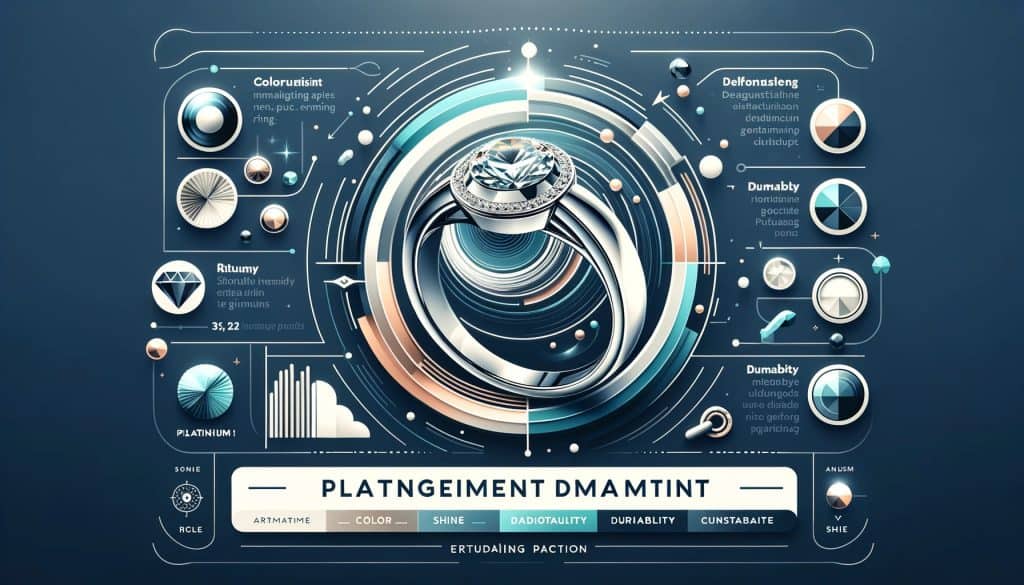
Characteristics of Platinum as a Ring Material
- Durability: One of platinum’s most notable attributes is its remarkable durability. It’s more resistant to wear and tear compared to gold, making it ideal for a lifetime of everyday wear.
- Color and Shine: Platinum’s natural white sheen doesn’t fade or tarnish over time. This enduring luster makes it a great backdrop for diamonds and other gemstones, enhancing their brilliance.
- Density and Weight: Platinum is denser and heavier than gold, giving a substantial and luxurious feel to the ring.
- Hypoallergenic Properties: Being naturally hypoallergenic, platinum is an excellent choice for people with sensitive skin.
Platinum vs. Gold: Durability and Appearance
When comparing platinum to gold, there are a few key differences to consider:
- Durability: Platinum is generally more durable than gold. It’s less prone to scratching and bending, making it an ideal choice for those with active lifestyles.
- Appearance: While high-karat gold can change shape over time, platinum maintains its form. Its natural white color also remains consistent, unlike white gold, which may require re-plating over time to retain its color.
- Cost: Platinum is typically more expensive than gold due to its rarity and density.
When to Choose Platinum for an Engagement Ring
Platinum is an excellent choice for those who:
- Prefer a ring that withstands daily wear without much maintenance.
- Are looking for a hypoallergenic option.
- Desire a metal that will securely hold precious stones in place.
- Value the heft and feel of a denser metal.
- Want a ring that symbolizes strength and enduring love.
Platinum’s blend of beauty, strength, and resilience makes it a standout choice for an engagement ring. Its ability to endure t ough the years while maintaining its elegance mirrors the qualities of a lasting relationship, making it more than just a metal choice — it’s a symbol of everlasting commitment.
< class="wp-block-separator has-alpha-channel-opacity"/>Silver: The Affordable Elegance
Silver, with its lustrous sheen and rich history, has been a cherished metal in jewelry making for centuries. Known for its affordability and elegance, silver offers a unique charm that has made it a popular choice for those seeking both beauty and value in their engagement rings.
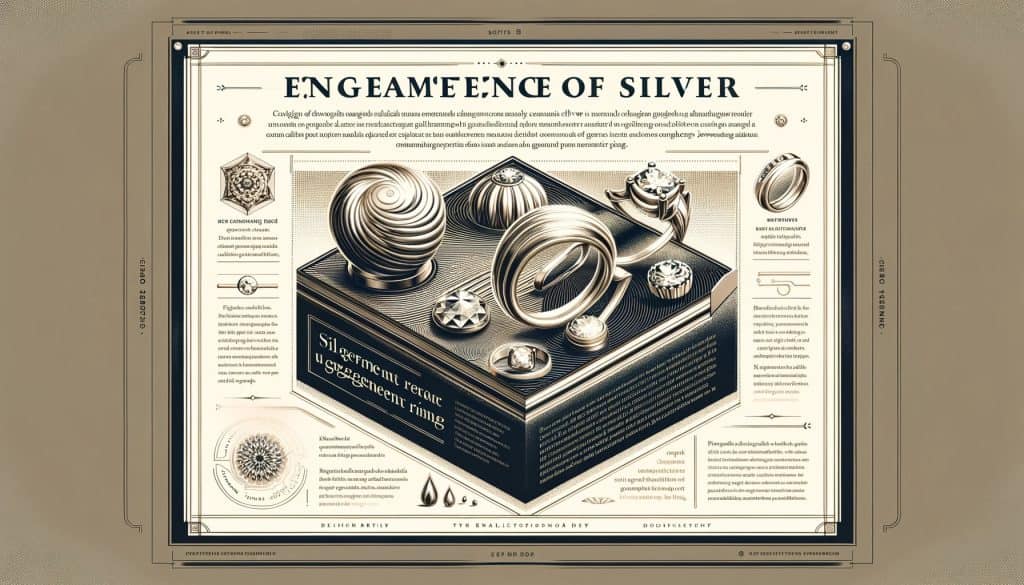
The Allure and History of Silver in Jewelry Making
- Historical Significance: Silver has been used in jewelry since ancient times, valued for its reflective quality and malleability. It has been a symbol of wealth and status in various cultures t oughout history.
- Aesthetic Appeal: The bright, white luster of silver gives it a modern and stylish look. It’s particularly appealing for those who prefer a cooler tone in their jewelry.
Advantages and Challenges of Silver Rings
- Advantages
- Affordability: One of the most significant advantages of silver is its cost-effectiveness. It offers the elegance of a precious metal without the high price tag of gold or platinum.
- Versatility in Design: Silver is soft and malleable, making it easy to work with. This allows for a wide range of intricate and detailed designs.
- Reflective Quality: Silver’s high reflectivity enhances the brilliance of gemstones set in it, particularly diamonds.
- Challenges
- Tarnishing: Silver can tarnish over time, requiring more maintenance to retain its shine.
- Softness: Being a softer metal, silver is more prone to scratches and dents, which means it may not withstand daily wear as well as harder metals.
- Alloy Considerations: Sterling silver, an alloy of silver and other metals, is commonly used in jewelry to increase durability, but it’s important to consider any potential allergies to these additional metals.
Caring for Silver Engagement Rings
To maintain the beauty of a silver engagement ring:
- Regular Cleaning: Use a soft cloth and a mild detergent to gently clean the ring. Special silver cleaners can also be used for deeper cleaning.
- Proper Storage: Store the ring in a cool, dry place, preferably in a tarnish-preventive bag.
- Avoid Chemical Exposure: Remove the ring during activities that may expose it to chemicals, such as swimming or cleaning.
- Professional Check-ups: Regular check-ups with a jeweler can help maintain the ring’s condition and address any signs of wear.
Choosing silver for an engagement ring is a statement of timeless elegance combined with practicality. Its affordability and beauty make it a compelling choice for those who value both tradition and modern aesthetics in their symbol of love.
< class="wp-block-separator has-alpha-channel-opacity"/>Alternative Metals: A New Age of Engagement Rings
In the world of engagement rings, traditional metals like gold and platinum have long dominated. However, alternative metals such as titanium, tungsten, and palladium are gaining popularity, offering unique benefits and a modern twist. These materials cater to a variety of styles and preferences, challenging the norms of traditional ring design.
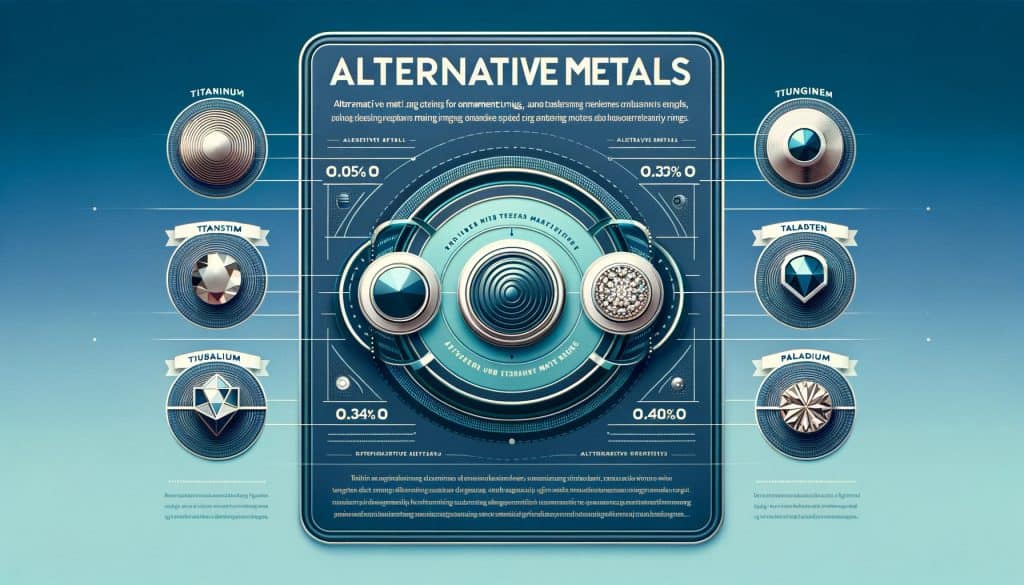
Exploring Titanium, Tungsten, and Palladium
- Titanium
- Benefits: Exceptionally lightweight and strong, titanium is perfect for those who are not accustomed to wearing jewelry. Its durability makes it ideal for active lifestyles.
- Unique Features: Titanium is known for its striking gray color and can also be anodized to produce different colors.
- Ideal For: Those seeking a modern look, athletes, and individuals with sensitive skin (hypoallergenic).
- Tungsten
- Benefits: Tungsten is one of the hardest materials used in jewelry, highly resistant to scratches. It’s heavier than other metals, giving a feeling of substance and quality.
- Unique Features: Tungsten maintains a permanent polish and shine, and it’s available in various colors, including classic gray and black.
- Ideal For: Individuals who work with their hands or who prefer a ring that withstands daily wear and tear without losing its luster.
- Palladium
- Benefits: As a member of the platinum group metals, palladium shares many characteristics with platinum, like natural whiteness and durability, but at a more affordable price.
- Unique Features: It’s lighter than platinum and hypoallergenic, making it comfortable for everyday wear.
- Ideal For: Those who appreciate the qualities of platinum but are seeking a more budget-friendly alternative.
Choosing Alternative Metals for Your Engagement Ring

The choice of metal for an engagement ring is deeply personal and should reflect the wearer’s style and life. Alternative metals offer a contemporary edge, practical benefits, and often, a more budget-friendly price point.
Whether you are drawn to the lightweight strength of titanium, the enduring shine of tungsten, or the elegant affordability of palladium, each metal brings its own unique story to your engagement ring. This choice is not just about trends; it’s about expressing individuality and choosing a ring that aligns with your personal narrative and lifestyle.
< class="wp-block-separator has-alpha-channel-opacity"/>Non-Metal Options: A World Beyond Traditional Rings
Engagement rings are evolving, and non-metal materials like wood, ceramic, and silicone are stepping into the spotlight. These unconventional choices offer a unique blend of style, comfort, and symbolism, catering to a diverse range of lifestyles and preferences.

Exploring Wood, Ceramic, and Silicone Rings
- Wood
- Characteristics: Wood rings showcase natural beauty and can come in a variety of colors and grain patterns. They often symbolize growth and a connection to nature.
- Suitability: Ideal for those who prefer a rustic, organic look or have an eco-friendly lifestyle.
- Care: Wood rings require regular oiling and should be kept dry to prevent warping or cracking.
- Ceramic
- Characteristics: Known for its durability and scratch-resistant properties, ceramic offers a modern, sleek appearance. It’s available in a range of colors, including classic white and black.
- Suitability: Perfect for those seeking a contemporary, low-maintenance ring.
- Care: While sturdy, ceramic can be brittle and should be protected from sharp impacts.
- Silicone
- Characteristics: Silicone rings are flexible, lightweight, and come in various colors. They are comfortable and safe for active lifestyles.
- Suitability: Ideal for athletes, healthcare workers, or anyone engaged in hands-on work.
- Care: Easy to clean with soap and water, silicone is highly durable and requires minimal maintenance.
Non-Metal Bands: Matching Your Lifestyle and Values
Choosing a non-metal engagement ring is about embracing individuality and practicality. These materials open up new possibilities for self-expression and functionality:
- Wood rings appeal to those who cherish nature and uniqueness.
- Ceramic offers a modern, sophisticated look with a robust build.
- Silicone is the go-to for active individuals who prioritize safety and comfort.
These options extend the boundaries of traditional engagement ring choices, allowing for a more personalized expression of love and commitment. Whether it’s the warm, earthy tones of wood, the sleek elegance of ceramic, or the versatile, carefree nature of silicone, each material tells a different story. In the end, the best choice is one that aligns with your personal narrative, values, and lifestyle.
< class="wp-block-separator has-alpha-channel-opacity"/>Mixing and Matching Materials: A Fusion of Style and Strength
The world of engagement rings is witnessing a captivating trend: the fusion of different materials in a single band. This innovative approach not only adds a unique aesthetic appeal to the ring but also enhances its durability and meaning.
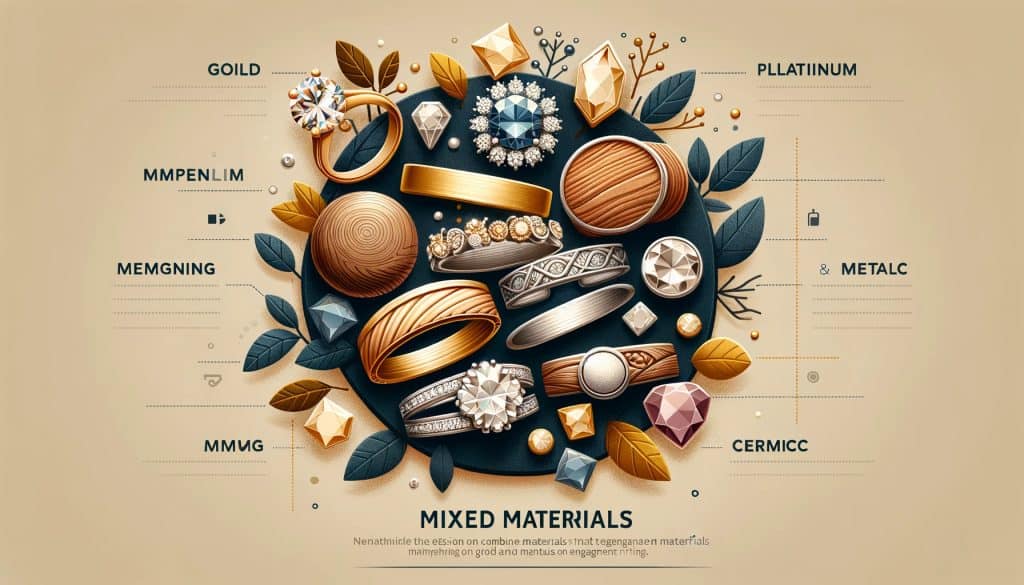
The Art of Combining Different Materials
The blend of various materials in ring design is more than just a fashion statement; it’s a reflection of creativity and personalization. Here’s how this trend is revolutionizing engagement ring designs:
- Enhanced Aesthetics: Mixing materials can create a striking contrast in color and texture, offering a ring that is truly one-of-a-kind.
- Increased Durability: Combining a softer material with a more durable one can increase the overall strength of the ring, making it suitable for everyday wear.
- Symbolic Meanings: Each material carries its own symbolism. Combining them can create a deeper representation of the couple’s journey and values.
Popular Material Combinations
- Gold and Platinum: The warmth of gold combined with the strength and durability of platinum creates a ring that is both luxurious and enduring.
- Wood and Metal: This combination brings together the natural beauty of wood with the resilience of metals like titanium or gold, symbolizing a harmonious blend of nature and strength.
- Ceramic and Silver: The sleek look of ceramic paired with the classic shine of silver offers a modern and sophisticated design.
Embracing the Mix-and-Match Philosophy
The choice to mix and match materials in an engagement ring is emblematic of a couple’s unique story. It’s about finding a balance between different elements that together, create something beautiful and lasting.
This approach allows couples to step beyond traditional boundaries and select a ring that truly represents their individual personalities and the unique bond they share.
Whether it’s the classic elegance of gold and platinum, the organic allure of wood and metal, or the contemporary chic of ceramic and silver, the mix-and-match trend offers endless possibilities to create a ring that is as unique as your love story.
This innovative approach in ring design not only brings a fresh perspective to traditional jewelry but also opens up new avenues for self-expression and creativity.
< class="wp-block-separator has-alpha-channel-opacity"/>Ethical and Sustainable Choices: Conscious Decisions in Engagement Rings
In today’s world, the journey of an engagement ring from mine to finger holds as much significance as the ring itself. Ethical sourcing and sustainability in ring materials are not just trends but are becoming imperatives for socially conscious couples. This shift reflects a growing awareness of the environmental and social impacts of jewelry production.

The Essence of Ethical Sourcing
Ethical sourcing in the context of engagement rings involves:
- Human Rights: Ensuring that the materials (especially gemstones and metals) are sourced from mines that do not exploit workers.
- Conflict-Free: Making certain that the sale of these materials does not fund conflict or violence, particularly in the case of diamonds (often referred to as ‘blood diamonds’).
- Environmental Protection: Choosing sources that minimize environmental damage and support sustainable mining practices.
Sustainable and Recycled Materials in Ring Making
- Recycled Metals: Using recycled gold, silver, or platinum reduces the demand for newly mined metals, thus decreasing the environmental footprint.
- Lab-Grown Diamonds and Gemstones: These are created in controlled environments, reducing ecological harm and ensuring no human rights abuses.
- Sustainable Practices: Some jewelers focus on sustainable practices t oughout their production process, from sourcing to the final product.
Making a Socially Responsible Choice
To make an engagement ring purchase that aligns with ethical and sustainable values:
- Research Jewelers: Look for jewelers who transparently share their sourcing and production practices.
- Certifications: Seek out certifications like the Kimberley Process for diamonds or Fairmined for gold, which ensure ethical practices.
- Ask Questions: Inquire about the origins of the ring’s materials and the sustainability practices of the retailer or designer.
- Consider Alternatives: Explore options like vintage rings or those made from alternative, eco-friendly materials.
Choosing an ethically sourced and sustainably made engagement ring is more than a fashion statement; it’s a reflection of values and a commitment to a better world. This choice represents a deep understanding and respect for the impact our decisions have on the planet and its inhabitants, adding another layer of meaning to the symbol of love and commitment the ring represents.
< class="wp-block-separator has-alpha-channel-opacity"/>Customization and Personalization: Crafting Your Unique Story
Customization and personalization in engagement rings are about more than just aesthetics; they’re about imbuing a piece of jewelry with personal significance and narrative. In an age where individual expression is highly valued, custom engagement rings offer a unique opportunity to create something that truly reflects a couple’s journey and preferences.

Options for Customizing Bands with Different Materials
Customizing an engagement ring can involve:
- Material Choices: Combining different metals like gold and platinum or incorporating non-traditional materials like wood or ceramic.
- Design Elements: Adding unique design features like intertwined bands or special finishes.
- Engravings: Personalizing with dates, initials, or meaningful quotes.
Personal Stories and Symbolism in Material Choice
The materials and design of a custom ring can carry deep symbolic meaning:
- Materials as Metaphors: Each material can represent different aspects of a relationship. For example, the durability of platinum could symbolize enduring love, while the warmth of gold might represent passion and warmth.
- Design as Narrative: The design elements can tell a story, like a band that twists to represent life’s journey or a setting that holds a stone from a significant place.
Working with a Jeweler to Design a Custom Band
Designing a custom engagement ring is a collaborative process that usually involves:
- Sharing Ideas: Bring your ideas, sketches, and inspirations to the jeweler.
- Exploring Options: Discuss different materials, designs, and cost considerations.
- Seeing the Vision Come to Life: Jewelers can often provide sketches or 3D models of the proposed ring.
- Revisions and Finalization: There may be a process of revising the design to ensure it aligns perfectly with your vision.
A custom engagement ring is more than just a piece of jewelry; it’s a wearable story that encapsulates personal memories, preferences, and aspirations. It’s a testament to the unique bond between two people, crafted to be as unique as their love.
Whether it’s t ough the selection of materials, the intricacy of the design, or the intimacy of personal engravings, a custom ring stands as a timeless reminder of a couple’s unique journey together.
< class="wp-block-separator has-alpha-channel-opacity"/>Caring for Your Ring Material: Ensuring Lasting Beauty and Integrity
Proper care and maintenance of your engagement ring are crucial to preserving its beauty and longevity. Different materials require specific care methods to maintain their shine and prevent damage. Here’s a guide to help you keep your ring looking as stunning as the day it was first worn.
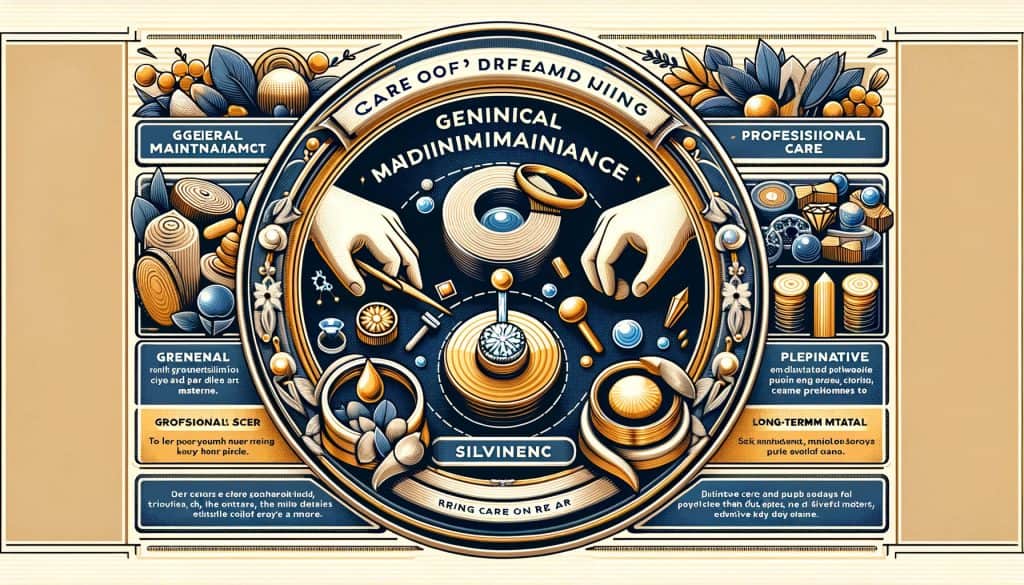
General Maintenance Tips for Different Materials
- Gold (Yellow, White, Rose)
- Regularly clean with a soft cloth and mild dish soap.
- Store separately to avoid scratches from harder jewelry pieces.
- Remove during heavy physical activities to prevent deformation.
- Platinum
- Clean with a soft brush and a solution of mild soap and warm water.
- Although durable, it can develop a patina over time, which can be professionally polished.
- Avoid exposure to harsh chemicals.
- Silver
- Polish regularly with a special silver cloth to prevent tarnish.
- Store in an airtight container with anti-tarnish strips.
- Avoid contact with perfumes, lotions, and other chemicals.
- Alternative Materials (Wood, Ceramic, Silicone)
- Wood: Use a soft, damp cloth for cleaning and apply natural oils to preserve the finish.
- Ceramic: Clean with soapy water; avoid hard impacts as it can be brittle.
- Silicone: Easy to clean with soap and water; extremely durable and low-maintenance.
Professional Care and Repair Considerations
- Regular professional check-ups are recommended for all ring types, especially for checking prong settings, clasps, and general wear.
- Resizing and repairing should be done by experienced professionals, especially for complex materials like platinum or rings with intricate designs.
Long-Term Preservation of the Band’s Beauty and Integrity
- Avoid exposing your ring to extreme temperatures, direct sunlight, and harsh chemicals.
- Consider removing your ring during activities that could cause damage, like gardening or sports.
- Insurance can be a wise investment for protecting against loss or significant damage.
Caring for your engagement ring is not just about maintaining its physical appearance; it’s about preserving a symbol of love and commitment. By following these care tips and understanding the unique needs of your ring’s material, you can ensure that this precious token of affection endures t ough the years.
< class="wp-block-separator has-alpha-channel-opacity"/>Conclusion: The Heart of the Matter in Engagement Ring Selection
As we conclude our exploration of engagement ring materials, it’s clear that the choice of band material is far more than a mere aesthetic decision. It’s a choice that intertwines with your lifestyle, reflects your personal taste, and fits within your budget, all while symbolizing your love and commitment.
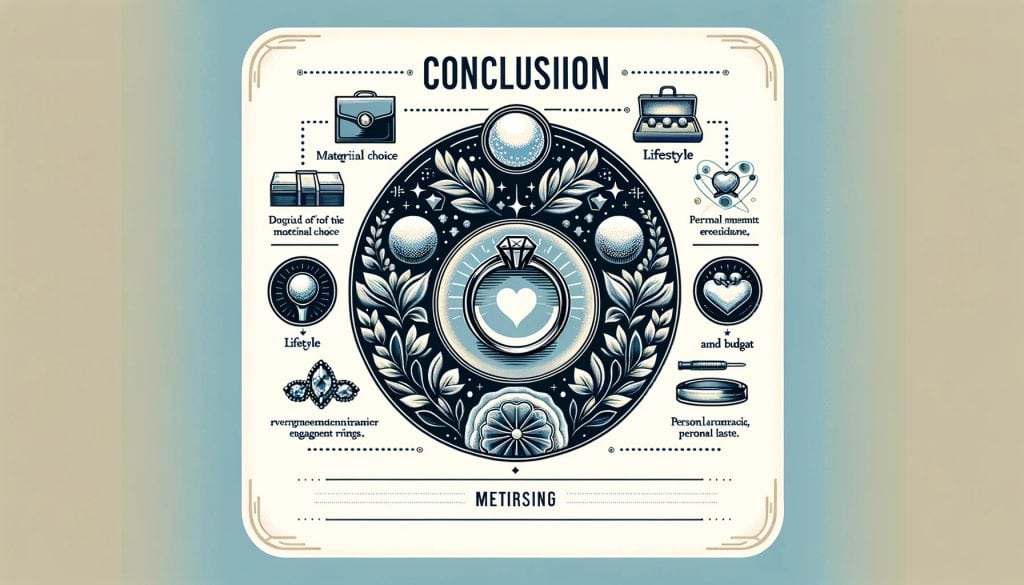
The Significance of Material Choice
- Reflecting Your Lifestyle: Your engagement ring should be a comfortable and enduring part of your daily life. The material you choose should complement and withstand your day-to-day activities.
- Matching Your Personal Taste: Whether you prefer the classic elegance of gold, the modern allure of platinum, or the unique charm of alternative materials, your ring should resonate with your personal style.
- Fitting Your Budget: From luxurious platinum to cost-effective silver, there’s a material option for every budget, ensuring that you can find a ring that’s both beautiful and affordable.
A Symbol of Love and Commitment
The engagement ring band is much more than a support for a sparkling gemstone; it’s the foundation of a piece that represents a pivotal chapter in your life. It holds the promise of a future together, a symbol of enduring love, and a constant reminder of the bond you share with your partner.
As you choose the material for your engagement ring, remember that each option tells its own story. The right choice is the one that best reflects your journey together, a decision that blends practicality with passion, and durability with beauty.
In the end, an engagement ring is a testament to your unique love story, and the material you choose for the band plays a crucial role in narrating that story. It’s a decision that merits careful consideration, for it’s not just about the ring itself, but about the love it represents and the memories it will come to hold.


